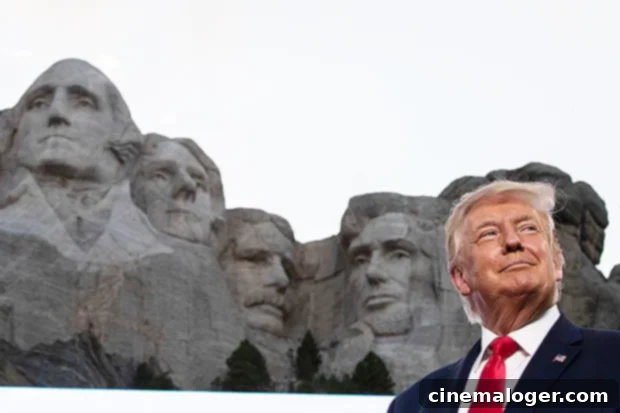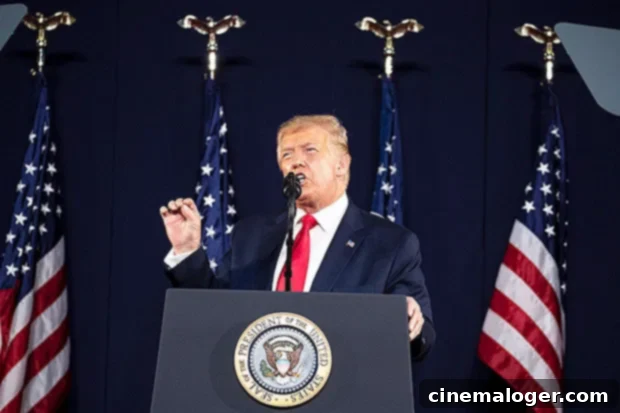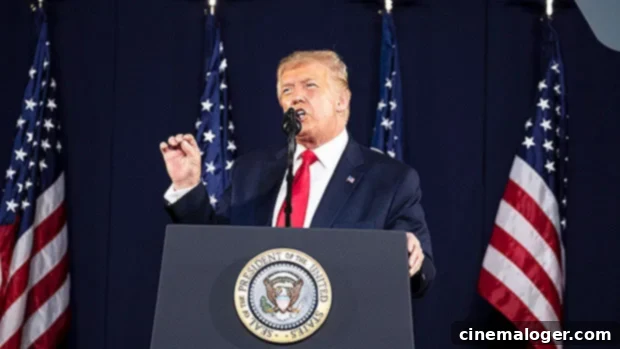Donald Trump’s Mount Rushmore Ambition: The Quest for a Fifth Face on the Iconic Monument
The notion of adding a fifth presidential face to the venerable Mount Rushmore National Memorial has long been dismissed as a fanciful pipe dream. However, reports surfaced that former President Donald Trump harbored a serious ambition to join the ranks of George Washington, Thomas Jefferson, Theodore Roosevelt, and Abraham Lincoln on the iconic South Dakota landmark. More remarkably, it was revealed that his administration reportedly took concrete steps to investigate the feasibility of this extraordinary request, sending ripples of disbelief and amusement across social media and political circles alike.
The story gained traction following an article in The New York Times, which cited a Republican party source indicating that a White House aide contacted the office of South Dakota Governor Kristi Noem. The purpose of the inquiry was seemingly to ascertain the procedures and requirements for adding another presidential bust to the colossal granite sculpture. This disclosure confirmed what many initially believed to be a humorous exaggeration: President Trump was genuinely invested in the idea of having his likeness etched into the Black Hills, a testament to his unique vision of presidential legacy.

Mount Rushmore: A Symbol of American Presidential History
Before delving deeper into Trump’s ambition, it’s essential to understand the profound significance and historical context of Mount Rushmore itself. Carved into the granite face of Mount Rushmore in the Black Hills region of South Dakota, this colossal sculpture represents 14 years of arduous work by artist Gutzon Borglum and his team, completed in 1941. The four presidents chosen for the monument each embody critical periods in American history and development:
- George Washington: Representing the birth of the nation and its struggle for independence.
- Thomas Jefferson: Symbolizing territorial expansion (Louisiana Purchase) and the ideals of democracy.
- Theodore Roosevelt: Honored for his role in industrial development, conservation efforts, and his leadership during a period of American growth.
- Abraham Lincoln: Commemorating the preservation of the nation during the Civil War and the abolition of slavery.
These four figures were selected not merely for their individual achievements but for their collective impact on the founding, growth, preservation, and development of the United States. The monument stands as a powerful symbol of American democracy, resilience, and the enduring principles upon which the nation was built. Its creation was an engineering marvel and a profound artistic statement, meticulously planned and executed with specific symbolic meanings attached to each figure and their placement.
Trump’s “Dream” Takes Shape and Governor Noem’s Role
President Trump’s aspiration to join this distinguished company was not a fleeting thought, but rather a persistent desire he vocalized on multiple occasions. Governor Kristi Noem recounted an early conversation with Trump in the Oval Office where his Mount Rushmore dream first came to light. “He said, ‘Kristi, come on over here. Shake my hand,’” Noem shared in a 2018 interview with Argus Leader. “I shook his hand, and I said, ‘Mr. President, you should come to South Dakota sometime. We have Mount Rushmore.’ And he goes, ‘Do you know it’s my dream to have my face on Mount Rushmore?’ I started laughing. He wasn’t laughing, so he was totally serious.” This interaction underscored the gravity with which Trump viewed his ambition, even as others perceived it as a whimsical notion.
Noem, aware of the president’s earnestness, played into this fantasy, especially during Trump’s high-profile Fourth of July rally at the base of Mount Rushmore in 2020. The governor presented him with a bespoke four-foot replica of the monument, uniquely featuring Trump’s face as the fifth president alongside the original four. During the event’s opening, Noem further fanned the flames by drawing comparisons between Trump and Theodore Roosevelt, a president revered for his progressive policies and monumental achievements—a comparison intended to legitimize Trump’s own vision of his place in history.

The White House Inquiry: From Dream to Official Pursuit
The revelation that a White House aide pursued an official inquiry into adding Trump’s image to Mount Rushmore elevated this story from mere presidential musings to a matter of serious—and widely scrutinized—administrative action. While the specifics of the aide’s contact with Governor Noem’s office remain somewhat vague, the fact that such an inquiry was made at all speaks volumes. It suggests that the desire was strong enough to warrant an exploration of its practical implications, even if those implications were astronomically improbable. This move, reported by The New York Times, underscored a willingness within the administration to entertain what most would consider an audacious, if not impossible, request.
For many, the inquiry highlighted a potential disconnect between the administration’s priorities and the public’s perception of appropriate governmental action. To engage resources, even minimally, for such a highly symbolic and logistically complex project, struck many as a curious allocation of time and effort. It also ignited a broader conversation about presidential legacies, the sanctity of national monuments, and the established processes for recognizing historical figures.
Public Reaction and Social Media Outcry
Upon learning of the reported White House inquiry, the internet, particularly Twitter, erupted in a flurry of reactions ranging from outright mockery to serious condemnation. The idea that a sitting president would actively seek to add his face to a nearly century-old national monument, alongside figures of such historical gravitas, was met with a potent mix of humor and incredulity. Social media users wasted no time in unleashing a torrent of satirical comments, memes, and impassioned arguments.
One popular line of humor involved suggestions for renaming the monument. As one Twitter user joked, “He’ll change the name to Mount Russia-More,” poking fun at alleged past connections. Others questioned the very premise, with MSNBC’s Matthew Miller tweeting, “Did I dream this or was it really reported this weekend that Trump asked the SD gov about adding his face to Mt Rushmore and the WH response wasn’t to deny it, but note it’s a federal, not state, monument, as if the fact he’s also an idiot helps?” This comment underscored the public’s frustration not only with the request itself but also with the perceived lack of a definitive denial from the White House, replaced instead by a jurisdictional clarification. Responses to such tweets further amplified the sentiment, with one user wryly remarking, “Let’s just be impressed that he contacted the correct state.”
Beyond the jokes, many expressed genuine concern and frustration. Critics argued that such an ambition reflected an inflated ego and a disregard for historical precedent and the artistic integrity of the monument. There was a widespread sentiment that presidential legacy is earned through historical impact and public consensus over time, not through self-assertion or administrative inquiry. The episode was seen by some as a symptom of a presidency characterized by a desire for grandiosity and personal glorification.
The Reality of Adding a Fifth Face: Logistical, Historical, and Cultural Hurdles
The notion of adding a fifth face to Mount Rushmore faces insurmountable obstacles on several fronts—logistical, historical, and cultural. From an engineering perspective, the existing sculpture utilized the most suitable granite on the mountain face. Borglum painstakingly selected this particular rock formation, and significant geological work, including dynamiting, was required to create the current masterpiece. There is no comparable, stable, and appropriately sized expanse of rock remaining on the mountain that could accommodate another bust without compromising the existing structure or requiring an entirely new, massive undertaking that would essentially destroy the original artistic vision.
Historically and symbolically, adding another face would fundamentally alter the monument’s intended meaning. The four chosen presidents represent distinct eras and contributions that together tell a cohesive story of the nation’s origins and development. Introducing a contemporary figure would disrupt this historical narrative and challenge the monument’s timeless significance. Moreover, the National Park Service, which oversees Mount Rushmore, has consistently stated that adding a fifth face is not only impractical but also goes against the spirit and intention of the original artwork and its preservation policies.
Furthermore, Mount Rushmore itself is a site of deep controversy, particularly for Native American communities. The Black Hills are considered sacred lands by the Lakota Sioux and other Indigenous peoples, and the carving of the presidents into what they consider sacred ground is a persistent source of pain and contention. The very presence of the monument is viewed by many as a symbol of colonial conquest and broken treaties. The idea of expanding the monument to include another figure, especially a controversial one, would undoubtedly intensify these long-standing grievances and spark renewed outrage from Indigenous rights advocates and environmental groups.
Conclusion: An Unlikely Aspiration
Donald Trump’s reported dream of seeing his face on Mount Rushmore, and the White House’s subsequent inquiry into its feasibility, remains one of the more peculiar footnotes in recent American political history. While his desire was undoubtedly earnest, the logistical, financial, historical, and cultural barriers make the prospect of a fifth face on Mount Rushmore an almost complete impossibility. The public’s reaction—a blend of humor, disbelief, and criticism—underscored the widely held belief that such an honor is reserved for historical figures whose legacies have withstood the test of time and earned near-universal recognition for their foundational contributions to the nation.
Ultimately, the episode serves as a powerful reminder of the enduring significance of national symbols like Mount Rushmore and the reverence with which they are held. It also highlights the differing perspectives on how presidential legacies are forged and whether they are self-proclaimed or bestowed by history. For now, the four majestic faces of Washington, Jefferson, Roosevelt, and Lincoln will continue to gaze out over the Black Hills, their solemn expressions undisturbed by any new additions, preserving their iconic place in the American landscape and collective memory.
